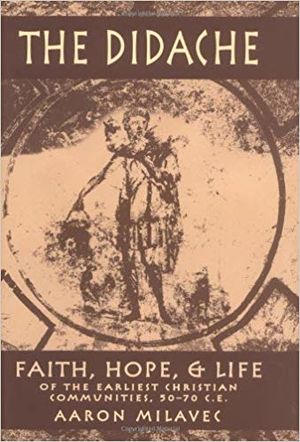The Didache: Faith, Hope, & Life of the Earliest Christian Communities (2003 Milavec), book
The Didache: Faith, Hope, & Life of the Earliest Christian Communities, 50-70 CE (20003) is a book by Aaron Milavec.
Abstract
"Most Christians believe that everything about Jesus and theearly church can be found in their New Testament. In recent years,however, the discovery of the Gospel of Thomas and the reconstruction of the Q-Gospel have led scholars to recognize that some very earlymaterials were left out. Now, due to the pioneering efforts of Dr. Aaron Milavec, the most decisive document of them all, namely, the Didache, has come to light. Milavec has decoded the Didache and enabled it to reveal its hidden secrets regarding those years whenChristianity was little more than a faction within the restless Judaisms of the mid-first-century ... The Didache reveals a tantalizingly detailed description of the prophetic faith and day-to-day routines that shaped the Jesus movement some twenty yearsafter the death of Jesus. The focus of the movement then was not uponproclaiming the exalted titles and deeds of Jesus - aspects that come to the fore in the letters of Paul and in the Gospel narratives. Incontrast to these familiar forms of Christianity, the focus of the Didache was upon "the life and the knowledge" of Jesus himself. Thus, the Didache details the step-by-step process whereby non-Jews were empowered byassimilating the prophetic faith and the way of life associated withJesus of Nazareth ... Milavec's clear,concise, and inspiring commentaries are not only of essential importance to scholars, pastors, and students but also very useful for ordinarypeople who wish to unlock the secrets of the Didache. Milavec'sanalytic, Greek-English side-by-side, gender-inclusive translation isincluded as well as a description of how this document, after beingfashioned and used 50-70 C.E., was mysteriously lost for over eighteenhundred years before being found in an obscure library in Istanbul. Thestudy questions, bibliography, and flowcharts enable even first-timeusers to grasp the functional and pastoral genius that characterized the earliest Christian communities ... Please note that Milavec has published two commentaries that carry the title, The Didache. The "mouse" is the shorter, hundred-page student edition published byLiturgical Press. The "elephant" is the thousand-page Paulist Presscommentary intended for those who want to examine, in full detail, howMilavec arrived at the conclusions in the "mouse" and how his pioneering studies find agreement and disagreement within the wide field of Didache scholarship."--Publisher description.
Editions
Published in New York, NY: Newman, 2003.
Contents
How the Greek manuscript was discovered, transcribed, and translated -- Greek text with side-by-side analytical translation -- The life-transforming training program -- The economic safety net in the Roman world of systematic exploitation -- Fasting, feasting, and the practice of baptizing adults -- Rhythms of fasting and praying until the kingdom comes -- Kingdom expectation celebrated in the Eucharistic meals -- How and why the Didache checked meddling prophets -- Learning gratitude by offering first fruits -- The confession of failings and Eucharistic sacrifice -- Community organization in a companionship of empowerment -- Purifying fire, selective resurrection, and God's coming -- Whether the Didache made use of any known gospel -- Whether the Didache reveals the social setting for "turning the other cheek" and "loving one's enemies" -- Whether final perfection requires observance of the Torah -- Whether the "hypocrites" were promoters of temple sacrifice -- Whether the "burning-process of testing" (Did. 16:5) offers evidence for the dual functioning of eschatological fire -- The spirituality of the Didache : modern reflections
External links
- [ Google Books]
